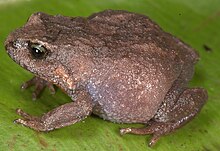Bryophryne hanssaueri
| Bryophryne hanssaueri | ||||||||||||
|---|---|---|---|---|---|---|---|---|---|---|---|---|

Bryophryne hanssaueri , holotype |
||||||||||||
| Systematics | ||||||||||||
|
||||||||||||
| Scientific name | ||||||||||||
| Bryophryne hanssaueri | ||||||||||||
| Lehr & Catenazzi , 2009 |
Bryophryne hanssaueri is in Peru occurring Froschlurchart from the family craugastoridae . Thespecific epithet was chosen in honor of the German Hans Sauer due to his sponsorship activities for the BIOPAT organization.
features
In the holotype of Bryophryne hanssaueri , a head-torso length (SVL) of 22.7 millimeters was measured. The SVL range in females varies between 18.1 and 24.6, and in males between 12.3 and 18.0 millimeters. The back has a gray-brown color and is provided with many small, wart-like, scattered humps, the flanks are somewhat lighter. The head is narrower than the body, the muzzle short and round. The colored throat, which is orange in the females and brownish to red-orange in the males, is typical of the species. There are also some orange spots in the hip area. The belly is spotted white-gray and gray-brown. The relatively short extremities are pale gray and marbled with a light brownish tinge. The males lack oestrus calluses and vocal sacs . Young animals show distinct dark brown spots and stripes on their heads and bodies. The iris shimmers green to golden.
distribution and habitat
The way has been only in a small area in Manú National Park in Peru east of Cusco on the eastern slopes of the Andes detected at altitudes from 3,100 to 3,700 meters. It prefers to live there in the Puna vegetation .
Way of life and development
Little is known about the way of life of Bryophryne hanssaueri . It is assumed that the conspicuous color of the throat is used either for intra-species communication or to deter potential predators. After mating, the female lays around 20 eggs, each 4.2 to 4.8 millimeters in diameter, and hides them in damp moss. There they go through a direct development on land without completing a tadpole stage in the water. The transformation to the finished young frog thus takes place within the egg.
Danger
Although the species has so far only been found in a very small area of 28.8 km² in the Manú National Park, the species is not acutely endangered as no negative changes, for example through reclamation of habitat, are to be expected in the national park . It is therefore classified by the World Conservation Organization IUCN as ![]() ( least concern = not endangered). The influence of climate changes requires further research.
( least concern = not endangered). The influence of climate changes requires further research.
Trivia
Due to the distinctive color of the throat, BIOPAT sometimes calls the species the “croaking robin”.
Individual evidence
- ^ A b c Edgar Lehr & Alessandro Catenazzi: Three New Species of Bryophryne (Anura: Strabomantidae) from the Region of Cusco, Peru . South American Journal of Herpetology, 4, 2, S: 125-138, 2009 doi : 10.2994 / 057.004.0204
- ^ Amphibian web
- ^ Red List
- ↑ Michigan News
- ↑ Croaking robin
Web links
- eol.org - Encyclopedia of Life

